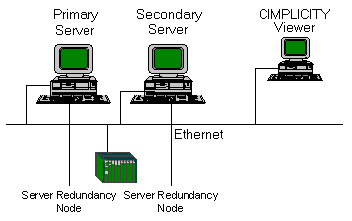CIMPLICITY software's Base System Functionality fully integrates Automatic Server Redundancy. This functionality transfers control from a primary to a secondary server when the primary goes down and, as a result, the connection between the primary and secondary is severed.
Redundant features are integrated into Point Management, Device Communications, User Registration and Alarm Management. The focus of redundancy in CIMPLICITY software centers on:
![]() Data collection
Data collection
![]() Applications driven by these
data
Applications driven by these
data
![]() Alarms
Alarms
![]() Users accessing these
applications
Users accessing these
applications
CIMPLICITY also offers the capability for manual redundancy. Manual Server Redundancy lets control be transferred from a primary to a secondary server, even if the primary is active and the two servers are connected. Transfer capability includes:
![]() Point management, including data
collection
Point management, including data
collection
![]() Entire project control
Entire project control
For CIMPLICITY Server Redundancy, there are two configured computers–the primary server and the secondary server.

A Primary Server is the Server that normally takes the primary role in a redundant configuration. Each Primary Server has one Secondary Server.
A Secondary Server is essentially a mirror image of the Primary Server. It runs the same version of the software as the Primary Server and communicates to the same devices. When the Primary Server fails, the Secondary Server assumes control of the appropriate functions that normally run on the Primary Server. A Secondary Server cannot be a primary configuration node, and does not support any configuration functions.
|
Server redundancy overview. |